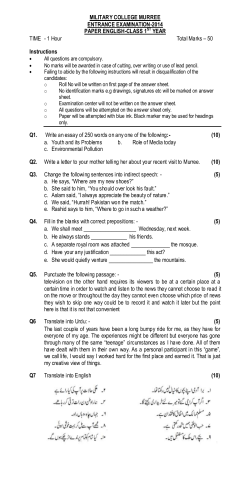
Science 9 Name: Class: 9 ____ Unit A Chapter 2 Assignment Each
Science 9 Name: _______________ _______________ Class: 9 ____ Unit A Chapter 2 Assignment Each multiple choice question is worth 1 mark. Alberta Environment has commissioned a study of the reproductive processes and inheritance patterns of the organisms in a new area proposed for protection. 1. It is observed that many of the poplar trees in the area appear to be developing from shoots or suckers. What form of reproduction does this represent? A. spore B. budding C. vegetative D. binary fission 2. During sexual reproduction, the sperm unites with the egg in the process of fertilization. What is created by the joining of these two cells? A. a gamete B. a zygote C. an embryo D. a bud 3. When a single-celled zygote divides into two cells, this begins the process known as A. cleavage B. binary fission C. budding D. vegetative reproduction 4. You observe binary fission as a method of asexual reproduction. What are three other forms of asexual reproduction? (3 marks) i. ____________________________________________________ ii____________________________________________________ iii. ___________________________________________________ Science 9 Name: _______________ _______________ Class: 9 ____ 5.Red squirrels captured in a proposed study area were different in size and mass. Which term best describes this range? A. heritable characteristic B. discrete variation C. non-heritable characteristic D. continuous variation 6. It is observed that a coyote has learned to use a farmer’s fence to corner its prey. What kind of characteristic is this? A. heritable characteristic B. discrete variation C. non-heritable characteristic D. continuous variation 7. What process occurs when the male gametes of an animal unite with the female gametes of an animal in sexual reproduction? A. embryo B. cleavage C. fertilization D. zygote Section B: Written Response Answer the following questions in the space provided. 1. a. What is the difference between heritable and non-heritable characteristics? Use examples to explain your answer. (2 marks) ______________________________________________________________________________ ______________________________________________________________________________ ______________________________________________________________________________ b. What is the difference between discrete and continuous variation? Use examples to explain your answer. (2 marks) ______________________________________________________________________________ ______________________________________________________________________________ ______________________________________________________________________________ Science 9 Name: _______________ _______________ Class: 9 ____ 2. a. LABEL the flower diagram (3 marks) 3 a) Name the male gamete of a plant: ___________________ b) Name the female gamete of a plant: ____________________ c) In plants, how does the male gamete reach the female gamete? ____________________ __________________________________________________________________________ d) What is the name of the first cell produced after the male and female gametes unite? _________________________ e) The first cell of the new organism divides by the process called _____________________ f) Inside the seed there is an undeveloped organism in its beginning stages called an __________________. 3. In the chart describe one advantage and one disadvantage for each type of reproduction.. (4 marks) advantage Asexual Sexual disadvantage Science 9 Name: _______________ _______________ Class: 9 ____
© Copyright 2026










